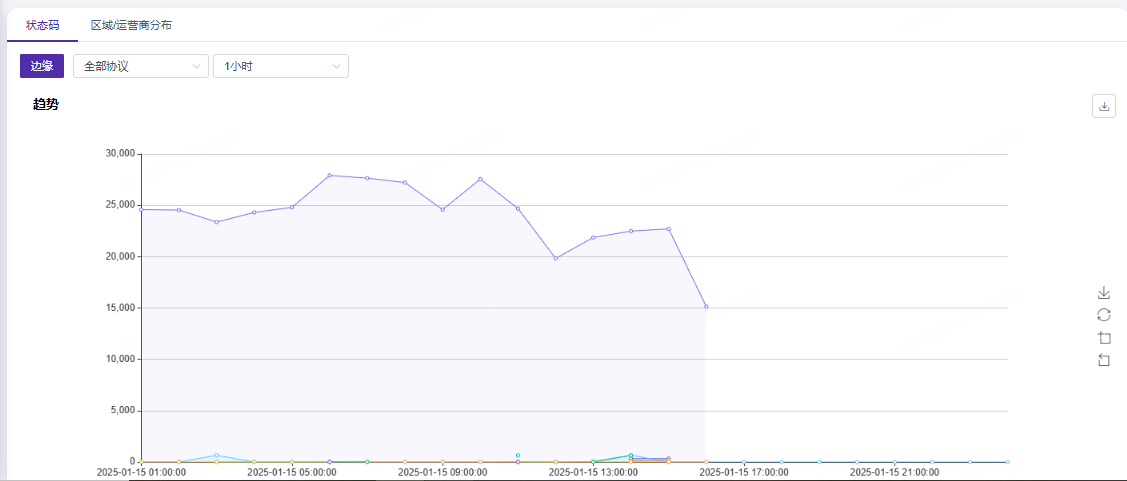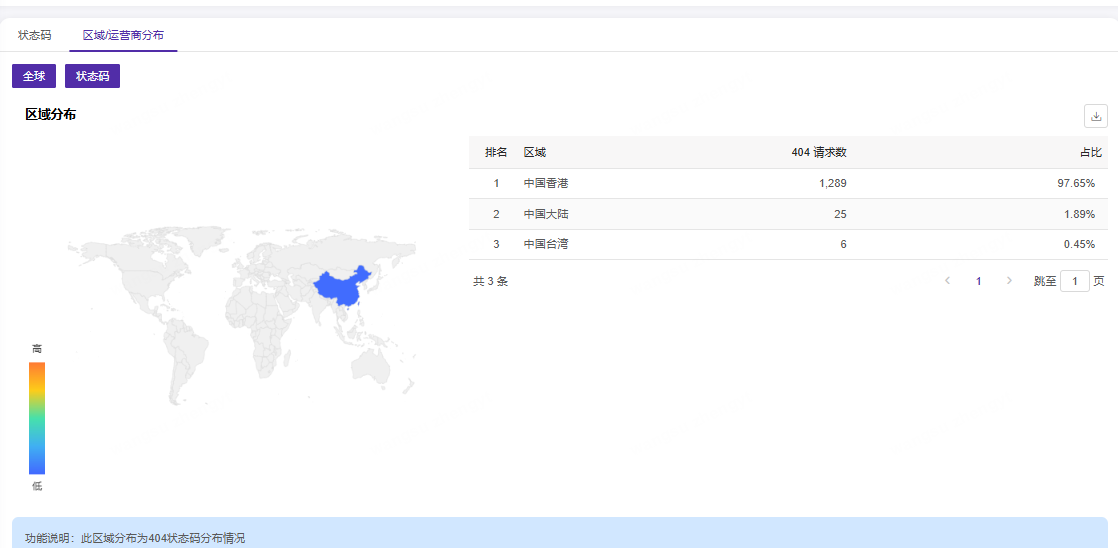状态分析
更新时间:2025-02-21 17:27:54
CDNetworks 提供详细的状态代码和区域分布数据,以支持您的业务分析和问题故障排除。
转至状态分析:
- 登录CDNetworks控制台,在**“已开通产品”**下找到正在使用的安全产品。
- 转到性能部分, 网站分析 > 状态分析。
1. 过滤数据
- 您可以选择时间范围、服务组和域名作为过滤器来查询数据的更多详细信息。
- 您将看到两个选项卡:状态码和区域/ 运营商分布。选择要查看的选项卡并单击它。
每个标签页展示不同维度的状态码数据,具体介绍请参见下文。
2. 状态码

提供三种报告:边缘、实时和回源状态代码:
- 边缘 :边缘状态码,默认提供小时粒度的状态码数据,也可以提供天等其他粒度。如果需要查看5分钟粒度的数据,可以点击申请开通开通数据采集,联系CDNetworks技术支持查看进度。开通后可以查询开通时间之后的5分钟详细数据。也可以点击实时查看5分钟粒度的状态码数据。需要注意的是,此报表的时效性比实时报表要低一些,比如现在是9:48 AM,你可能只能看到9:35甚至更早的状态码数据,这个数据延迟十多分钟。
- 实时:边缘状态码,默认提供5分钟粒度的状态码数据,不支持其他粒度过滤。此报表的时效性比边缘报表高,例如现在是9:48 AM,则可以看到9:45及之前的状态码数据。
- 回源:回源状态码,包括边缘服务器和中继服务器的状态码,默认提供5分钟粒度的状态码数据,也可以提供小时、天等粒度。
由于边缘报告和实时报告的数据来源和采集方式不同,因此两者的数据可能会有细微差异,仅供参考。如果希望以5分钟粒度查看数据,建议优先查看实时报告的状态码数据。
趋势
所有状态码报表均提供两个维度的状态码数据,您可以根据需要在汇总和详细之间切换。
- 聚合:按照下面设定的规则聚合不同的状态代码进行显示。
- 详细:直接显示状态代码,无需聚合。
| 状态代码类型 | 状态码 |
|---|---|
| 成功 | 200,210,206 |
| 重定向 | 302,301,303,305,307 |
| 未修改 | 304 |
| 允许 | 400,401,403,405,406,407,408,409,410,411,412,413,414,415,416,417,421,422,423,424 |
| 未找到 | 404 |
| 服务器错误 | 500,501,502,503,504 |
| 其他的 | 0,-1 |
细节
您可以在这里查看各个特定状态码对应的请求数及占比。
此外,边缘报告还会额外显示错误详情。点击状态码对应的详情按钮,可以查看该状态码对应的TOP URL及其引荐来源和请求。如有需要,您可以导出更多TOP URL。

3. 区域及运营商分布
展示404状态码的地域分布,包括404状态码的请求数量及占比。

本篇文档内容对您是否有帮助?
有帮助
我要反馈